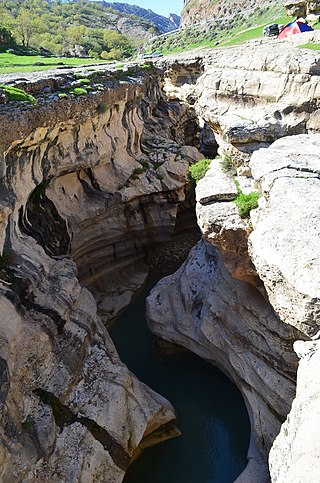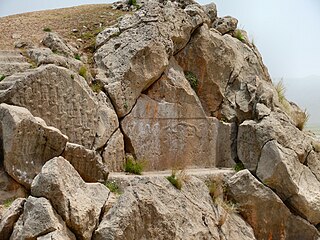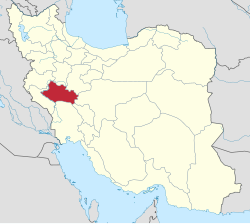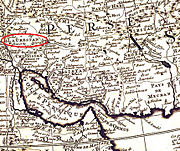
Ilam province is one of the 31 provinces of Iran. Its capital is the city of Ilam. The province is in the western part of the country in Region 4 and covers 20,164.11 km2 (7,785.41 sq mi). It shares 425 km (264 mi) of the border with Iraq, and also bordering on the provinces of Kermanshah, Lorestan, and Khuzestan.

The Bakhtiari are a Lur tribe from Iran. They speak the Bakhtiari dialect of the Luri language.

Luri is a Southwestern Iranian language continuum spoken by the Lurs, an Iranian people native to Western Asia. The Luri dialects are descended from Middle Persian and are Central Luri, Bakhtiari, and Southern Luri. This language is spoken mainly by the Bakhtiari and Southern Lurs in Iran.
Laki is a vernacular that consists of two dialects; Pish-e Kuh Laki and Posht-e Kuh Laki. Laki is considered a Kurdish dialect, by most linguists and is spoken chiefly in the area between Khorramabad and Kermanshah in Iran by about 680,000 native speakers.

Khorramabad is a city in the Central District of Khorramabad County, Lorestan province, Iran, serving as capital of the province, the county, and the district.

Borujerd is a city in the Central District of Borujerd County, Lorestan province in western Iran, serving as capital of both the county and the district.
Lak is a Kurdish tribe native to Western Iran. They speak Laki, which is considered a Kurdish dialect by most linguists.
The Zand tribe is a Laki-speaking Kurdish tribe mainly populating the countryside of Khanaqin in Iraq and in the provinces of Kurdistan and Hamadan of Iran.

The Lurs are an Iranian people living in western Iran. The four Luri branches are the Bakhtiari, Mamasani, Kohgiluyeh and Lur proper, who are principally linked by the Luri language.
The Khorshidi dynasty, Abbasi dynasty or Shahs of Little Lorestan (1184–1597) was a Lur dynasty that ruled Little Lorestan in the later Middle Ages from their capital Khorramabad.
The majority of the population of Iran consists of Iranic peoples. The largest groups in this category include Persians and Kurds, with smaller communities including Gilakis, Mazandaranis, Lurs, Tats, Talysh, and Baloch.
Shah Reza is a village in Beyranvand-e Jonubi Rural District, Bayravand District, Khorramabad County, Lorestan Province, Iran. At the 2006 census, its population was 11, in 4 families.
Khuzestani Arabs are the Arabic speaking inhabitants of the Khuzestan province and the largest Arabic speaking community in Iran which primarily reside in the western half of Khuzestan. The capital of Khuzestan is Ahvaz. As of 2010, Khuzestani Arabs numbered around 1.6 million people.
The Feyli Lurs are a collection of Lur tribes that primarily live in the Lorestan province of Iran. Their dialect is almost identical to that of standard Persian.

Southern Lurs are a large part of Lurs who natively speak the Southern Luri language a branch of Western Iranian languages, and are an Iranian people. They occupy some regions in Southwest of Iran including Kohgiluyeh and Boyer-Ahmad (fully), Southeastern parts of Khuzestan Northwestern parts of Fars, and Western parts of Bushehr Province.
Qadam Kheyr of the Qalavand tribe, was a notable Luri woman of the late Qajar and early Pahlavi period in Iran.

Luri music is referred to an ethno-cultural characteristic of Lurs in the Middle East. Luri music enjoys a various and ancient background.

Ahmed Lur was a primary Luri follower of the Hurufism school of Sufi Islam in 15th century in Iran. He was one of the disciples of Fazlallah Na'imi, the founder of the Hurufism sect.
Lurs are an Iranian people living mainly in western and southwestern Iran. There is also a significant population of Lurs in eastern and central parts of Iraq The word Luristan or Lorestan, is attributed to the areas inhabited by the Lurs. The boundaries of Luristan stretch from the eastern Iraqi plains to the west and southwest of Iran. Today, Lorestan is the name of one of the western provinces of Iran.

Luti people, also known as Tushmal are a group of people in southwestern Lorestan and adjacent parts of Chaharmahal and Bakhtiari Province in Iran. Luti people are considered outcasts, polluted and inferior by the general society and no numbers exist on their population.


























